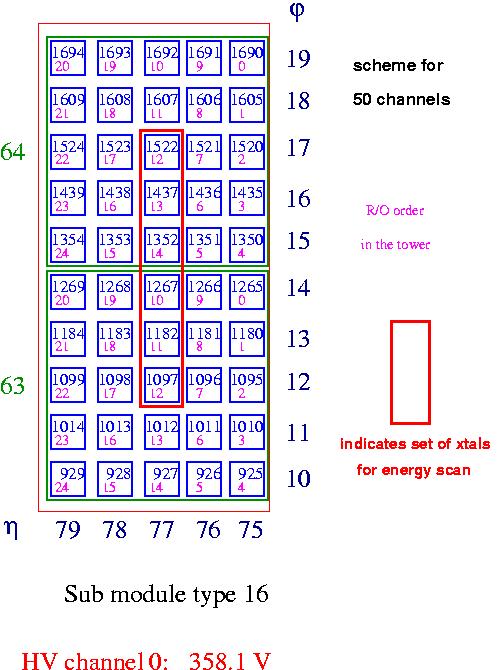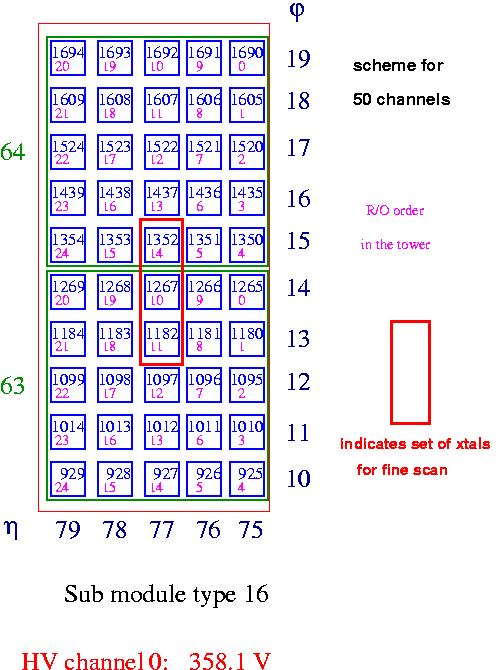Definition of Run Types (for 50 xtals):
General remarks :
- normal data taking should be in AutoGain mode.
- normal trigger scintillator is S2, which is 20x20mm
- S2 rate : 2.5k counts/burst is the upper limit to avoid xtal damage
- 2.5k S2 counts/burst will give 1000 DAQ events (due to dead time)
- Note : 1300 DAQ events/burst is the maximum due to file size limitations
- SPS burst (or spill) length = 4.8 s, cycle length 16.8 s
==> Number of bursts/hour = about 214
==> number of bursts/minute = 3.6
- Laser runs: need to be taken at 20-30 min intervals, during any run
type. At present it is intended that the Run Control will automatically cycle
through three different laser wavelengths (probably 440nm, 495nm and 800nm),
2k events/frequency. At the moment the 800nm does not have a safety cut-off
for excess laser amplitude. 600nm will be used until this is in place.
- Note : all numbers (length of runs etc) are very preliminary, no SPS etc.
efficiency factor,
ie. no contingency
- GARAGE POSITION is now at y = 8000
Mandatory whenever you are changing the beam energy
Top of page...
Slow scan : Allocation : Old = 4 days,
Current = 2 days
- Table is moved "by hand". In steps crystal-to-crystal (see help
for table moving)
- 30k evts/xtal, 20x20mm trigger ==> 1 run of 30k evts = about 8.4 min
- repeat laser run after each row of 5 or 10 xtals (or after about
20-30 min) !
- sequence:
- Laser, Pedestal, temperature and leakage current runs
- FixedGain, Gain 9, E= 120 GeV, 50 xtals
If Gain 9 saturates for a xtal, repeat with Gain 5 ?
==> beam time required : about 420 min= 7h
- + table time + setting + laser runs = 3h ?
==> Total = 10 h
- AutoGain, E= 120 GeV, 50 xtals
==> beam time : as for 1) = about 10 h
- AutoGain, E= 50 GeV, 50 xtals
==> beam time : as for 1) = about 10 h
- Laser, Pedestal, temperatures, leakage currents
==> total time estimated =30 h + 18h contingency
Top of page...
Laser scan : current allocation = 1
day during MD
- All four Laser frequencies to be taken: BLUE 440, GREEN 495 nm; RED 709nm;
INFRARED 800nm.
- all xtals will be simultaneously illuminated by each Laser burst
- Laser data: Free Gain and Fixed Gain with all four gains, 2k evts/frequency
- Assuming 500 evts between each spill gives 4 spills for 2k evts
- 1 minute needed to change frequency
- Therefore, about 2.5 min total/ frequency
- 5 frequencies x 5 gain settings = 25 run types ==> less than or around
1h
- During MD repeat it at 1h intervals
Top of page...
Fast autoscan : Allocation : old
= 4 days, new estimate = 1 day with about 20 h contingency
- Table is moved automatically.
- For first running, in order to understand the necessary statistics to
achieve 0.2% precision or better, the
following allocation is foreseen:
- 2.5k S2 counts/burst with 20x20mm, 4 bursts/xtal, should give 4k DAQ evts.
- The table movement will take about 2 bursts.
==> 6 burst/xtal => 1.7 min/position ==> about 1.4 h for 50 xtals
- Laser run needed every 20 mins (every 10 xtals), could be done for 1 gain
mode
during 1 burst.
If a different procedure for the laser run is needed,
a parking position may need to be defined (out of the beam).
- Note : table should not move during pedestal or laser runs because of noise
induction.
- sequence :
- Pedestal, temperature, leakage current run
- AutoGain, E=50 GeV, 100 xtals
- AutoGain, E=120 GeV, 100 xtals
- Pedestal, temperature, leakage current run
==> total time estimated = around 4 h
Top of page...
Energy scan, 1x6 array: Allocation
: current estimate = 2 days (1 day contingency)
- proposed set of xtals (click on image to get larger view) :
 PDF
PDF
- 50k DAQ evts/xtal/energy, 20x20mm trigger, 2.5k S2 counts/burst.
==> 14min /xtal/energy ==> 1.4 h / energy beam time + table movement
==> 13h total + table movement
- Xtals : constrained 5x10 region, which includes the 1x6 xtal set in the
centre (see proposed diagram).
- Table movement : see instructions close to the table PC in case of problems.
- Laser/pedestal/temp/leakage curr: every 20 minutes, so every 1 to 2 runs
- E-scan : 20 - 280 GeV, in steps according to beam files :
20 - 35 - 50 - 80 - 120 - 150 - 180 - 210 - 280 = 9 energies. 0.5 h for each
energy setting
==> about 5 h for energy setting in total
- Not needed before MD on Sep 3 : One Autoscan (calibration) over the 5x10
xtals every 12 h approx. (expected time 4 h)
==> about 22h in total + table time
Top of page...
Fine scan in eta-phi: Allocation
: 2 days (no contingency)
- proposed set of xtals
 PDF
PDF
- move table in 2mm steps across a xtal (might be optimized)
- 3 xtals along eta in the middle of the 1x6 set used for the energy scan
- 20 k DAQ evts/step, Energy = 120 GeV
- 5x5 mm trigger should have max 156 counts/burst (eq. S2 upper limit 2.5k
counts/burst)
- this gives 62 DAQ evts/burst = 322 bursts in order to get 20k DAQ evts
Last year : about 130 runs, 75 hours.
This year : about 33 steps.
322 burst/step = approx 1.5 h/step ==> 50 hours total
Note : extra events near boundaries?
Top of page...
Uniform coverage scan: Allocation
: 2 days (1.25 days contingency)
- across whole area of the 1x6 xtal set (as used for the E-scan)
- 1cm table movement each step in eta and phi to cover whole area
===> around 24 points
- S2 (20x20mm) trigger
- laser/peds/temp/leakage curr runs at the end of each eta sweep
- 50k DAQ evts/point ==> 14 min / point ==> about 6h per energy
- Energies : 120 GeV and 50 GeV
===> total time : 12h + energy change + moving + laser + peds = approx 16
h
Top of page...
Pion run: Allocation : 2 days
- 1 day each for 10 and 20 GeV
- this means, 0.5 days for setting up with electrons, and 0.5 days taking
data
- Cerenkov counters have been requested, but are not yet installed
Top of page...
SM at + (or -) 1 sigma to IP
: current allocation : 3 days
- 3 days allocated for now
- details to be discussed
Top of page...
Temperature tests
(email Giovanni Franzoni) agreed allocation : 2 days
- Before the beginning of data taking, connect cooling water, leave the module
(xtals)
to thermalize (~8 hours), electronics off , APD high voltages on.
Turn on the electronics.
Follow behaviour of the channels by reading out the thermistors (2 h).
See how much is the temperature variation of the APD's. APDs are expected
to thermalize within 2 h.
This would be very useful also to calibrate the temperature sensors.
- One 2 degree temperature step scanning with both beam and laser
both on the increase and on the decrease (1.5 days).
- If any significant effect has been detected in i),
redo the same thing as in i) reading APD's for a laser scan (2h).
NOTE : note exact time when the LV is applied!
Top of page...
R-measurement: Allocation: 7 days
S2 20x20mm2 counter
6.7*10-6 rads/S2 count, at shower max (assuming Gaussian beam
profile, sigma 2cm).
Use rate collimators (COLL 1 and COLL 6).
Increase rate equally in X and Y
Try to avoid changing momentum byte collimator (COLL 3)
- Start with a Laser/ped/temp/leak run
- E=120 GeV
- 3 runs with S2 at 2.5k counts/burst to get reference. 20k DAQ events each
run
- Increase rate to 20k S2 counts/burst = 30 rads/h
- (could go to 30k S2 counts/burst = 45 rads/h if possible)
- the availbale rate will depend on the beam sharing with other beam lines
- Limit DAQ to take 1k events/burst (avoid large data volumes)
- 8 hours per crystal
- during this 8h period, take laser runs every 20 mins with beam on
- Try to expose up to 20 xtals
Important request : 8h irradiation + 8h recovery / xtals, do not irradiate
the 5x5 xtals around it during these 8h .
***** Can this be changed to 3x3 ??? in view of 50 xtals only **********
If in addition it is required that all the xtals from the E-scan are irradiated,
this gives as set of xtals which still has to be decided on.
==> total time needed : 7 days (to be counter-checked)
Top of page...
25ns run:
we will use this for normal data taking....
Top of page...
 PDF
PDF
 PDF
PDF
 PDF
PDF